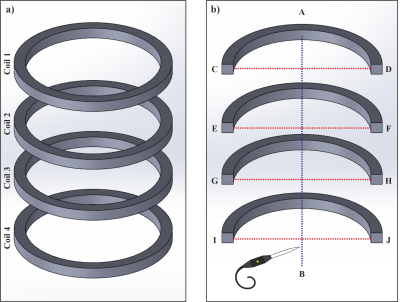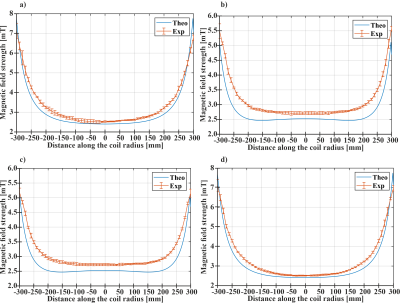3103
Design and Development of a Hybrid Helmholtz Coil System for Production of Low Magnetic Field System (up to 7 mT)1Institute of Health Sciences, Ege University, IZMIR, Turkey
Synopsis
In this study, the design and construction of a hybrid Helmholtz coil system and numerical modelling were investigated for production of homogeneous magnetic field over a volume of interest that consist of cylindrical geometry (h=700mm, r=90mm). The 4‑coil system was constructed and tested by two commercially available low power DC power supplies. The magnetic field created by the 4‑coil system was found to be B=2.5182±0.0035mT over the volume of interest. We found that the simulated and measured magnetic fields are in good agreement (R=0.9759, p<0.05).
Introduction
The novel hyperpolarized magnetic resonance imaging technologies does not required the use of high‑field MR systems and the imaging can be performed with the low magnetic field MR strengths in the order of 5mT 1–4. Creating a homogeneous low magnetic field throughout a volume of interest (VOI) that includes the body parts to be imaged is of great importance in terms of image quality and is very challenging. Another important relevant application of the low magnetic field is the spin exchange optical pumping (SEOP) technique that is used to polarize noble hyperpolarized contrast agents including 1H, 3He, 7Li, 13C, 15N, 19F, 31P, 83Kr, and 129Xe 5. In this study, a hybrid Helmholtz coil configuration was simulated and designed providing a homogeneous magnetic field and excellent efficiency for the use of SEOP system and/or low-field MR imaging systems.Materials and Methods
Numerical simulations: A hybrid Helmholtz system geometry was simulated in MATLAB for optimizing magnetic field homogeneity and field strength of coil system that consist of four coils as shown in Figure 1. The magnetic field was computed by solving Biot‑Savart laws using a fixed mesh size of 2mm. The 4‑coil system consisted of (i) two pairs of larger coils (i.e. coils I and IV in Figure 1) with an inner‑diameter of 600mm that are separated from center for 425mm which has a turn number of 140, (ii) two smaller coils (i.e. coils II and III in Figure 1) with an inner‑diameter of 600mm that are separated from center for 127mm which has a turn number of 80. Electric current values were selected based on the maximum currents supplied by the DC power sources (Marxlow KXN-3020D).Design and construction: A total length of 860m copper wire with a diameter of 3mm were reel on aluminum cylinders for building the coil pairs. Each coil pair was driven with two separate power sources and fed with an electric current of approximately 10A for controlling the magnetic field uniformity.
Measurement of magnetic field: The generated magnetic fields along the coil axis from point A to B and radii from point C to D (Figure 1) are measured using a gaussmeter (PCE‑MFM‑3000) with 10mm distances. The measured magnetic field compared to the simulated magnetic field using Spearman’s correlation. The VOI is chosen to be 700mm long, 90mm wide and in the middle of the coil systems.
Results
The 4‑coil hybrid system produced a magnetic field up to 7mT when fed with an electric current of 20A. The cross‑section of simulated magnetic field is shown in Figure 2a.The simulated and measured line profiles along the coil axis (from A to B in Figure 2a) are also shown in Figure 2b. The magnetic field variations were less than 3% within the VOI. The experimental results measured along the coil radii are also compared with the line profiles of the 4‑coil system that corresponds to the line profiles shown in Figure 3. Correlation values between experimental and simulated line profiles: A‑B, C‑D, E‑F, G‑H, and I‑J were 0.976, 0.988, 0.978, 0.982 and 0.988, respectively with p‑values are lower than 0.001.Discussion
Magnetic field values and homogeneity over the VOI of designed system were suitable for the purpose of use (SEOP and low field MRI) according to simulated and measured results. The magnetic field homogeneity simulated with the 4‑coil system was close enough to the system with quite large dimensions (2000mm) previously used by another team 1, showing that the 4‑coil system was suitable for a large region of interest with the advantage of smaller dimensions. The experimental measurements showed that the simulated and measured magnetic fields was statistically in agreement and homogeneity was acceptable for the purpose of use and for a large VOI. Further improvements may include a fifth coil driven with a separate power supply for fine shimming in between the larger coils with varying turns.The difference of ~5% between experimental and theoretical values that may originate from the sensitivity of the gaussmeter or the amplifying effect of the coil spools/surrounding ferromagnetic materials, which is in agreement with the similar results in literature showing the experimental magnetic field measurements can be 0.02mT above the simulated magnetic field. While there are more homogeneous magnetic field generating systems that include four circular coils in the literature, such as Lee-Whiting et al.6, the VOI is usually much shorter than our study for the same physical dimensions.
Acknowledgements
This work was supported by the TUBITAK Project No 118C189.References
1. Mair RW, et al. 3He Lung Imaging in an Open Access, Very-Low-Field Human MRI System. Magn Reson Med. 2005;53(4):745-749. doi:10.1002/mrm.20456
2. Dominguez-Viqueira W et al., A variable field strength system for hyperpolarized noble gas MR imaging of rodent lungs. Concepts Magn Reson Part B Magn Reson Eng. 2008;33(2):124-137. doi:10.1002/cmr.b.20111
3. Tseng CH et al., Low-field MRI of laser polarized noble gas. Phys Rev Lett. 1998;81(17):3785-3788. doi:10.1103/PhysRevLett.81.3785
4. Wong GP et al., A System for Low Field Imaging of Laser-Polarized Noble Gas. J Magn Reson. 1999;141(2):217-227. doi:10.1006/jmre.1999.1904
5. Barskiy DA et al., NMR Hyperpolarization Techniques of Gases. Chem - A Eur J. 2017;23(4):725-751. doi:10.1002/chem.201603884
6. Lee-Whiting GE, Uniform magnetic fields, At. Energy Project Canada, ChalkRiver Project Res. Develop., Ottawa, ON, Canada, Tech. Rep. CRT-673, 1957, p. 28.
Figures


